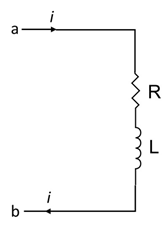Answer
64.8k+ views
Hint: In this question, use the Kirchhoff’s law to calculate the values of resistance and the inductance of the circuit. According to Kirchhoff's law potential difference is equal to the product of current and resistance and sum of the inductance.
Complete step by step answer:
Let us consider figure (1), we have given a circuit with current of \[2\;{\text{A}}\] and increasing at rate of \[1\;{\text{A/s}}\], the measured potential difference \[{V_{ab}} = 8\;V\]. And when the current is \[2\;{\text{A}}\] is decreasing at the rate of \[1\;{\text{A/s}}\] the measured potential difference \[{V_{ab}} = 4\;V\].
As we know, Kirchhoff’s law states that the current flowing inside the circuit and outside the circuit will be the same. Kirchhoff’s law is also known as the conservation law of the current.
Now, we calculate the value for the potential difference as,
\[ \Rightarrow {V_A} - IR - L\dfrac{{dI}}{{dt}} = {V_b}\]
After simplification we get,
\[ \Rightarrow {V_A} - {V_b} = IR + L\dfrac{{dI}}{{dt}}\]
Now we substitute the value of current and the potential difference,
\[8 = 2R + L\left( 1 \right)\]
Simplify the equation and we get
\[8 = 2R + L......\left( 1 \right)\]
Simplify the above equation again and get,
\[ \Rightarrow \dfrac{{8 - L}}{2} = R\]
Now, we calculate the value for the potential difference \[{V_{ab}} = 4\;V\]
\[ \Rightarrow {V_A} - IR - L\dfrac{{dI}}{{dt}} = {V_b}\]
After simplification we get,
\[ \Rightarrow {V_A} - {V_b} = IR + L\dfrac{{dI}}{{dt}}\]
Now, we substitute the value of current and the potential difference,
\[ \Rightarrow 4 = 2R + L\left( { - 1} \right)\]
Simplify the equation and we get
\[ \Rightarrow 4 = 2R - L\]
Put the value of \[R\] in equation in the above equation,
\[ \Rightarrow 4 = 2\left( {\dfrac{{8 - L}}{2}} \right) - L\]
After simplification we get,
\[\therefore L = 2\;{\text{H}}\]
Now, we substitute the value of \[L\] in equation \[\left( 1 \right)\]
\[ \Rightarrow 8 = 2R + 2\]
After simplification we get,
\[\therefore R = 3\;\Omega \]
Therefore, The value of \[{\text{R}}\] is \[3\;\Omega \] and the value of \[{\text{L}}\] is \[2\;{\text{H}}\].
So, the option \[\left( A \right)\] is correct.
Note: In this question, do not forget to write the SI unit of the frequency. And the SI unit of the inductance is Henry\[\left( {\text{H}} \right)\].Conservation of the current law means the current inside and outside is the same.
Complete step by step answer:
Let us consider figure (1), we have given a circuit with current of \[2\;{\text{A}}\] and increasing at rate of \[1\;{\text{A/s}}\], the measured potential difference \[{V_{ab}} = 8\;V\]. And when the current is \[2\;{\text{A}}\] is decreasing at the rate of \[1\;{\text{A/s}}\] the measured potential difference \[{V_{ab}} = 4\;V\].
As we know, Kirchhoff’s law states that the current flowing inside the circuit and outside the circuit will be the same. Kirchhoff’s law is also known as the conservation law of the current.
Now, we calculate the value for the potential difference as,
\[ \Rightarrow {V_A} - IR - L\dfrac{{dI}}{{dt}} = {V_b}\]
After simplification we get,
\[ \Rightarrow {V_A} - {V_b} = IR + L\dfrac{{dI}}{{dt}}\]
Now we substitute the value of current and the potential difference,
\[8 = 2R + L\left( 1 \right)\]
Simplify the equation and we get
\[8 = 2R + L......\left( 1 \right)\]
Simplify the above equation again and get,
\[ \Rightarrow \dfrac{{8 - L}}{2} = R\]
Now, we calculate the value for the potential difference \[{V_{ab}} = 4\;V\]
\[ \Rightarrow {V_A} - IR - L\dfrac{{dI}}{{dt}} = {V_b}\]
After simplification we get,
\[ \Rightarrow {V_A} - {V_b} = IR + L\dfrac{{dI}}{{dt}}\]
Now, we substitute the value of current and the potential difference,
\[ \Rightarrow 4 = 2R + L\left( { - 1} \right)\]
Simplify the equation and we get
\[ \Rightarrow 4 = 2R - L\]
Put the value of \[R\] in equation in the above equation,
\[ \Rightarrow 4 = 2\left( {\dfrac{{8 - L}}{2}} \right) - L\]
After simplification we get,
\[\therefore L = 2\;{\text{H}}\]
Now, we substitute the value of \[L\] in equation \[\left( 1 \right)\]
\[ \Rightarrow 8 = 2R + 2\]
After simplification we get,
\[\therefore R = 3\;\Omega \]
Therefore, The value of \[{\text{R}}\] is \[3\;\Omega \] and the value of \[{\text{L}}\] is \[2\;{\text{H}}\].
So, the option \[\left( A \right)\] is correct.
Note: In this question, do not forget to write the SI unit of the frequency. And the SI unit of the inductance is Henry\[\left( {\text{H}} \right)\].Conservation of the current law means the current inside and outside is the same.
Recently Updated Pages
Write a composition in approximately 450 500 words class 10 english JEE_Main

Arrange the sentences P Q R between S1 and S5 such class 10 english JEE_Main

What is the common property of the oxides CONO and class 10 chemistry JEE_Main

What happens when dilute hydrochloric acid is added class 10 chemistry JEE_Main

If four points A63B 35C4 2 and Dx3x are given in such class 10 maths JEE_Main

The area of square inscribed in a circle of diameter class 10 maths JEE_Main

Other Pages
A boat takes 2 hours to go 8 km and come back to a class 11 physics JEE_Main

Electric field due to uniformly charged sphere class 12 physics JEE_Main

In the ground state an element has 13 electrons in class 11 chemistry JEE_Main

According to classical free electron theory A There class 11 physics JEE_Main

Differentiate between homogeneous and heterogeneous class 12 chemistry JEE_Main

Excluding stoppages the speed of a bus is 54 kmph and class 11 maths JEE_Main




